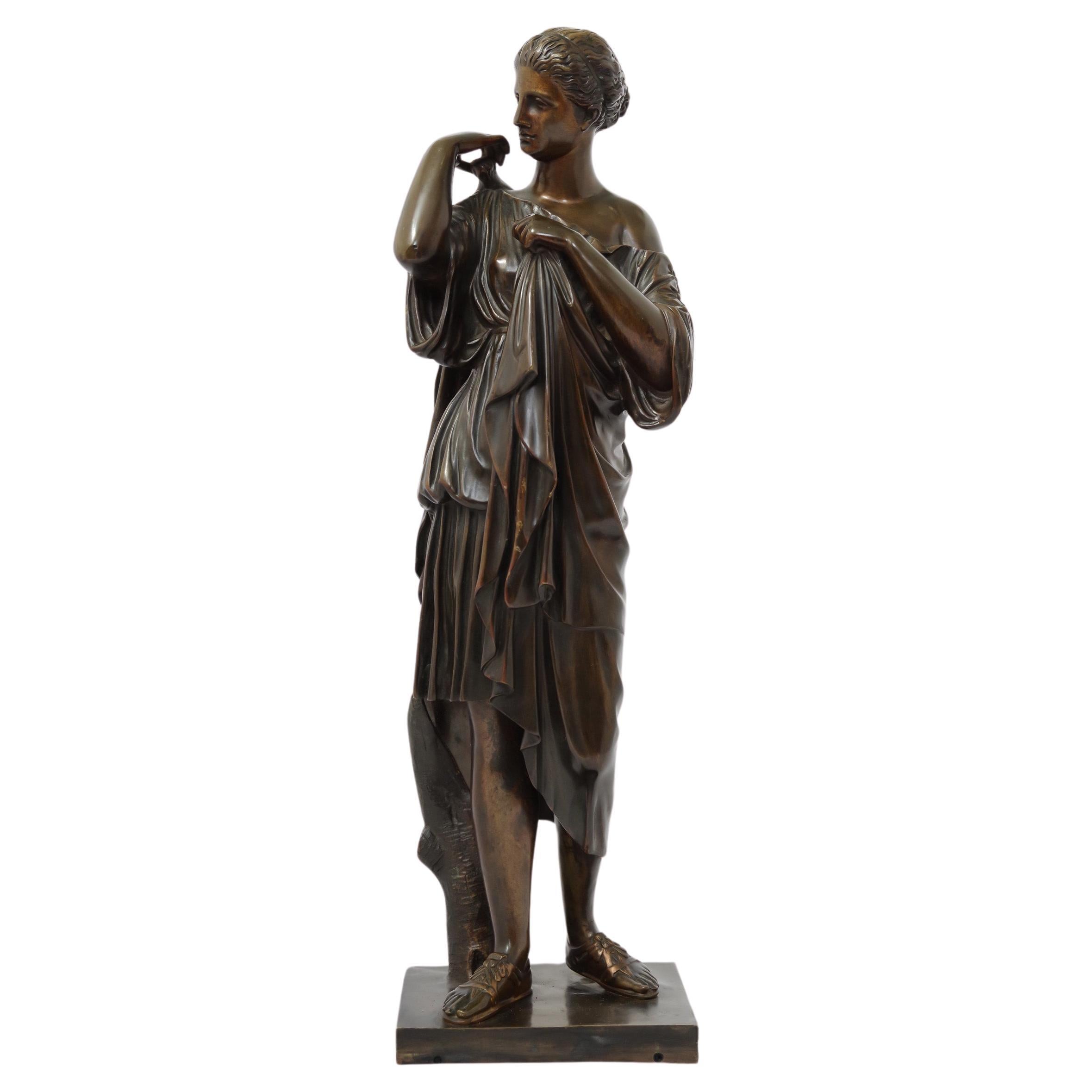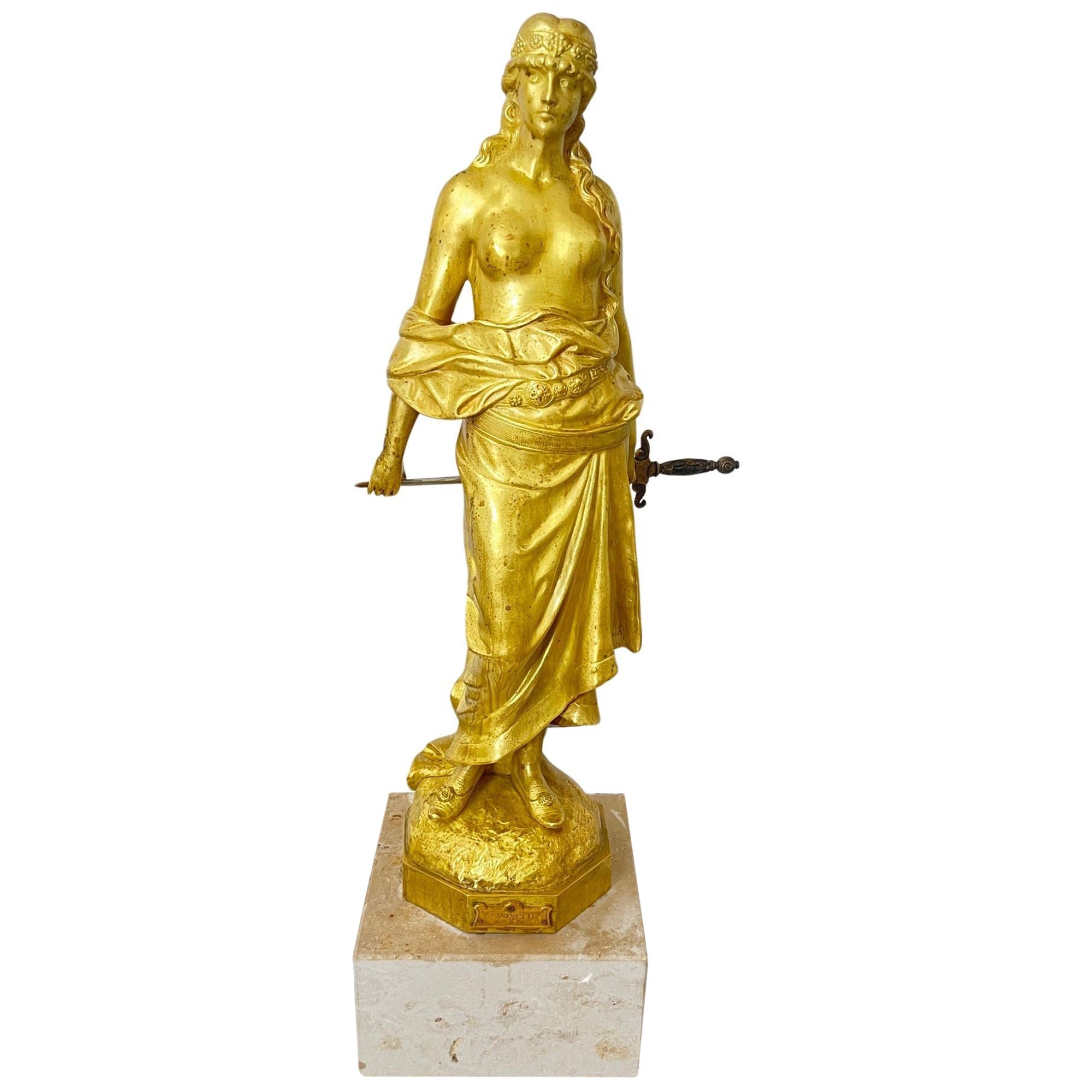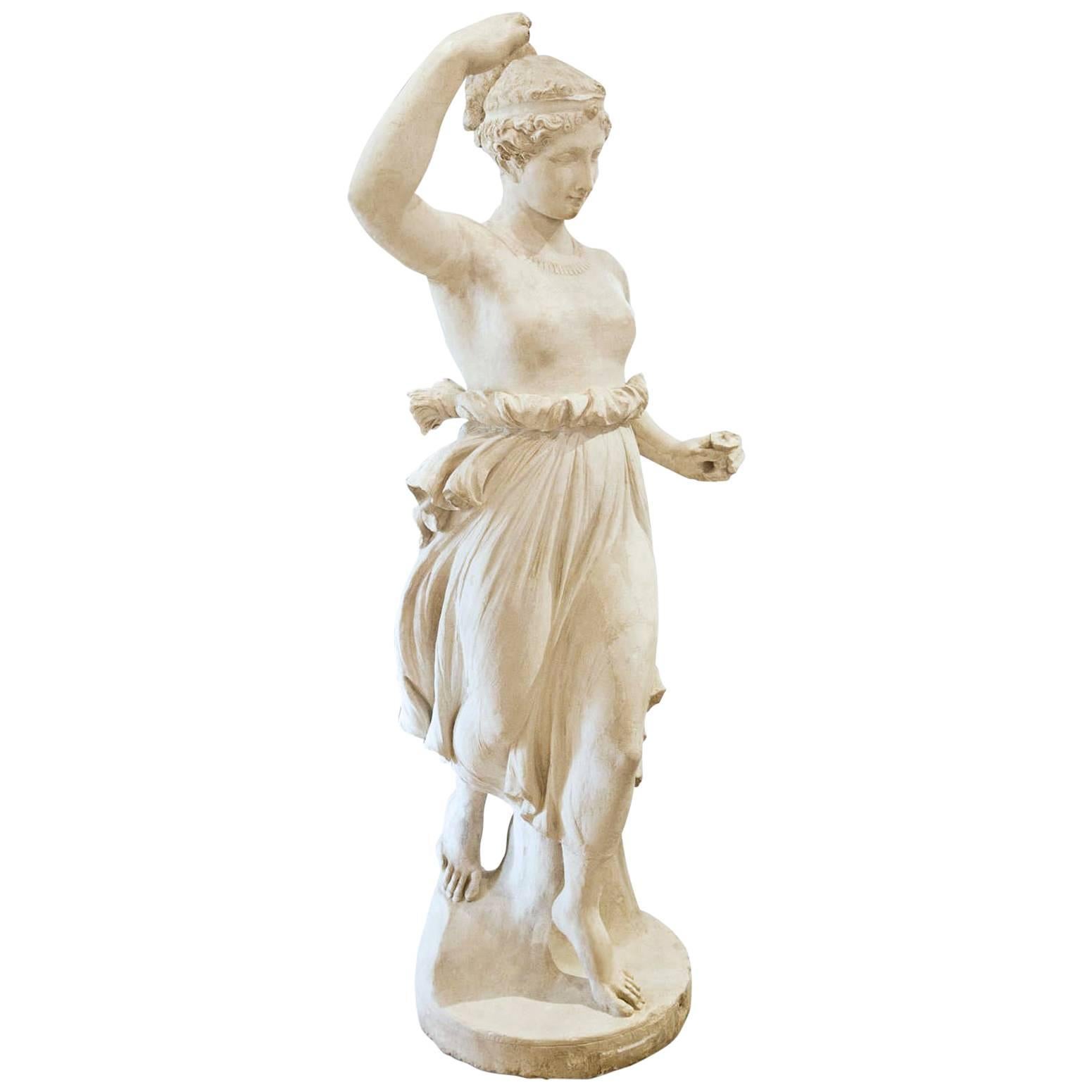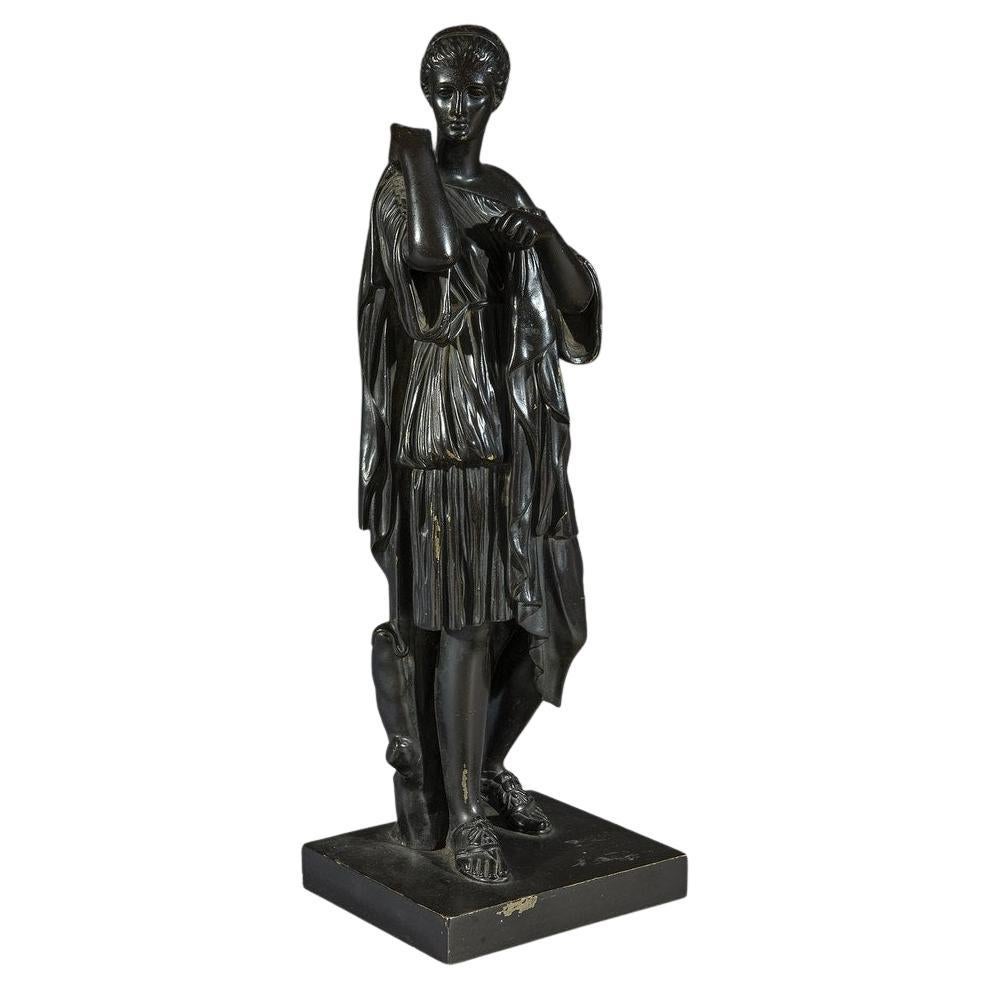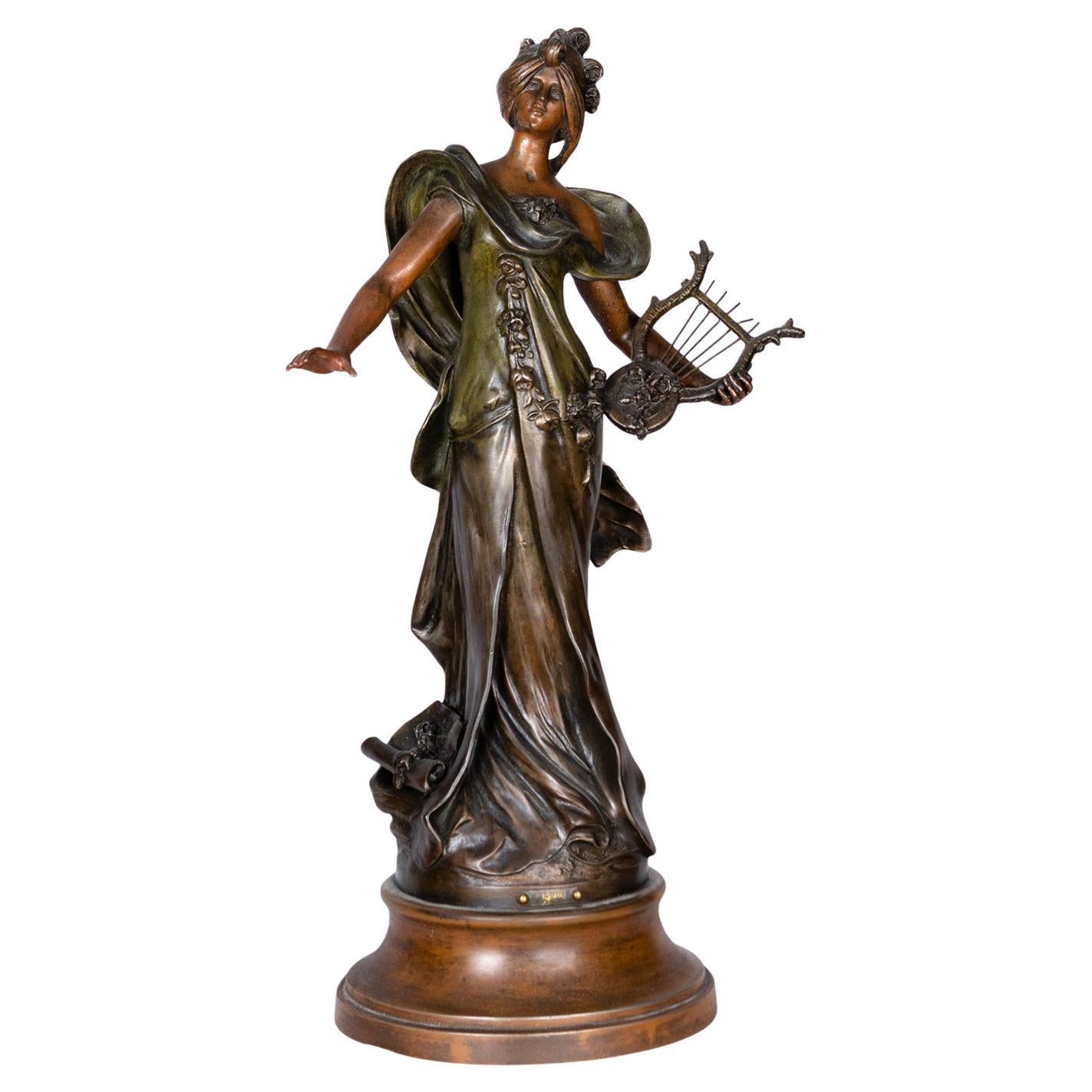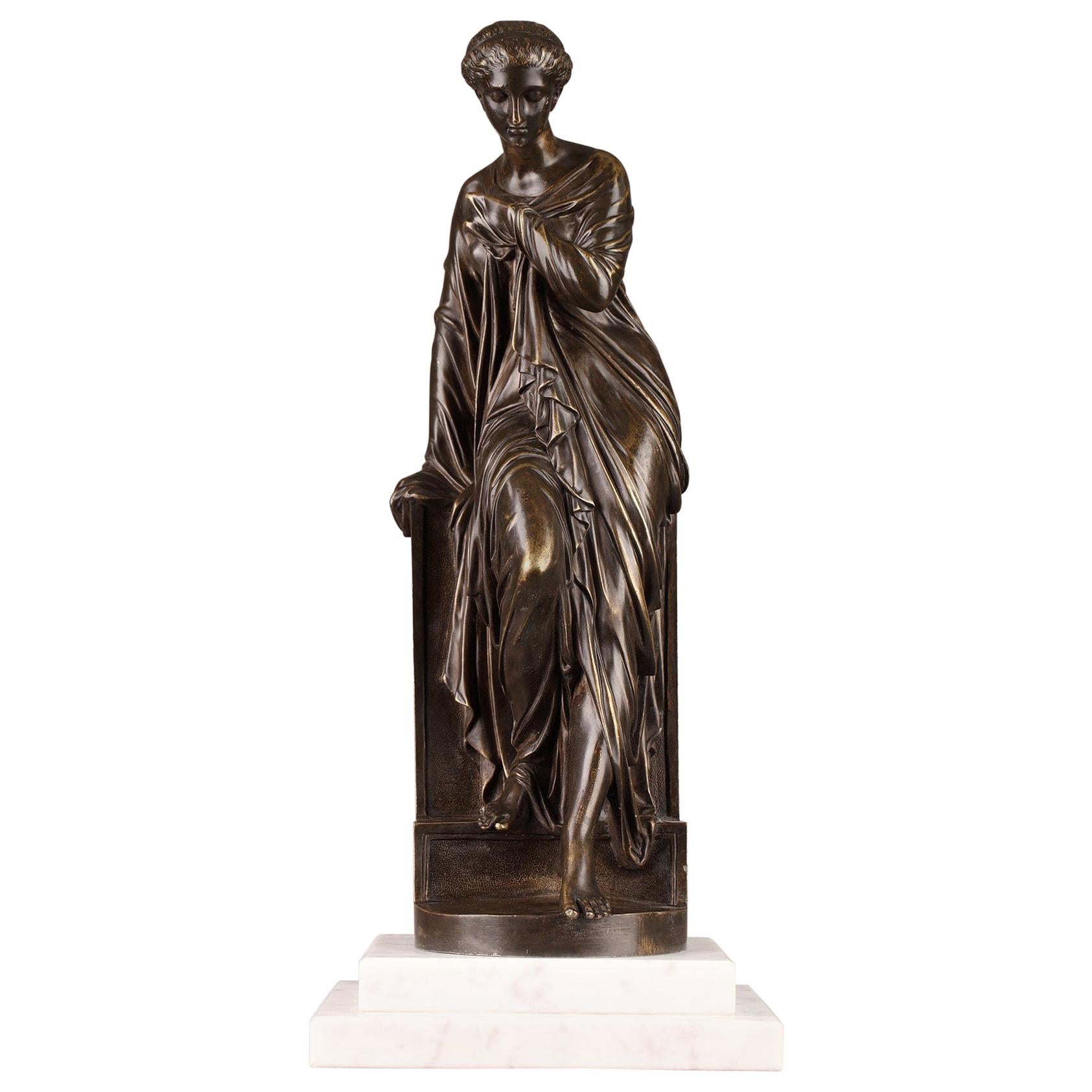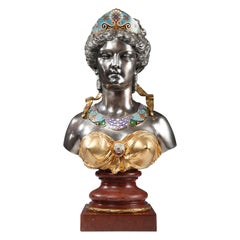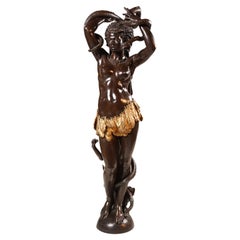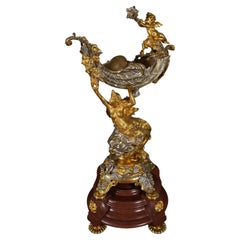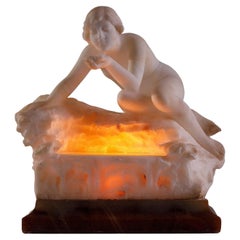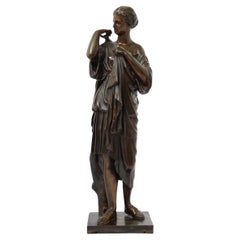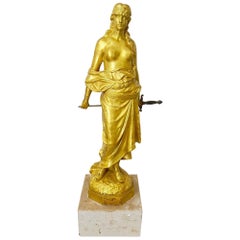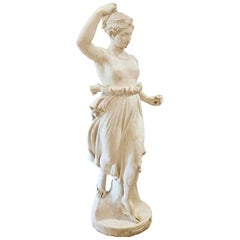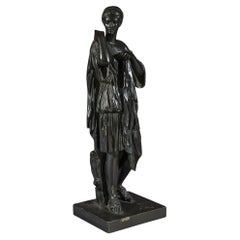Items Similar to "Giuditta" by Ezio Ceccarelli, Italy, Circa 1900
Video Loading
Want more images or videos?
Request additional images or videos from the seller
1 of 16
"Giuditta" by Ezio Ceccarelli, Italy, Circa 1900
$417,518.96
£308,677.19
€350,000
CA$574,291.06
A$638,360.18
CHF 334,614.72
MX$7,795,922.27
NOK 4,177,471.71
SEK 3,930,221.57
DKK 2,664,544.18
About the Item
Great female statue of Judith in bronze with brown patina and white marble from Carrara. This young woman holds in her hands, stretched over his head, a scimitar in its scabbard, ready to draw it. The weapon is fitted with a hilt decorated by a stylized lion on the top of the sword guard, adorned with an Egyptian scarab with outstretched wings. The face, in white marble, with gentle characteristics and half-closed eyes looked down at the viewer, is topped with two braids meeting at the back of the head, the whole encircled by a headband adorned with golden piastres. The liberator, slightly swaying, is dressed in a loose-fitting bronze tunic and antique-style drapery, embellished with a belt adorned by a beetle with outstretched wings. The bottom of the tunic is decorated with stylized vegetal motifs, revealing her sandals.
The sculpture rests on a base of Verona red marble, the whole set on a fluted column of Florence serpentine with a rectangular top and molded circular base.
Height of the statue: 166 cm (65,35 in.); Height with the base: 268 cm (105,5 in.) ; Width : 85 cm (33, 46); Depth : 57 cm (22,44 in.)
Although any male figure is associated with it to our knowledge, the theme of this symbolist sculpture is Judith and Holofernes. Indeed, Judith, a young widow of extraordinary beauty, wanting to save her city besieged by the Assyrian general, decides to behead him after having charmed and intoxicated him. The figure of Judith, which in our sculpture combines several stylistic elements from the Mediterranean basin such as an Egyptian scarab, an Ottoman scimitar, a Caucasian headband and a Greek-inspired tunic, is sculpted before the general's death, in an attitude of contemplation. This evocation stimulates our imagination, inviting us to take a journey through civilizations.
Working mainly in marble, Ezio Ceccarelli also experimented into bronze and other materials, as in our sculpture "Giuditta" circa 1900 and this helmeted female head, circa 1905. This latter depicted half-closed eyes in an interiorized attitude, giving great delicacy and fullness to the idealized face, a principle also present in the Ecce Homo bust of 1899.
This infatuation with polychrome sculptures and the mixing of materials can be linked to the research carried out in France by the sculptor Louis-Ernest Barrias (1841-1905), whose famous "La Nature se dévoilant" of 1899 is now in the Musée d'Orsay, in a bid to revive archaeological discoveries on the polychromy of ancient Greek sculptures, or to rival their chryselephantine sculpture in aesthetic terms.
Biography :
Ezio Ceccarelli (1865-1927), born in Montecatini Val di Cecina, was an Italian sculptor who has begun his apprenticeship at the Academy of Rivalta and Bortone in Florence, a city he particularly loved, later becoming a teacher himself at the Industrial Art School in Volterra. In addition to his teaching activities, he founded a sculpture studio in Florence, welcoming both students and collaborators. Thanks to this workshop and the resulting recognition, he took part in numerous competitions, including the statue of King Carlo Alberto in Rome, winning the first Curlendese prize in Bologna in 1899 and, above all, the gold medal for his statue Ecce Homo in the Gregorian competition in Rome. His virtuosity and renown spread far and wide, thanks to his participation in numerous international competitions, including those in Liège, Copenhagen and Athens. He represented Italy at the Exposition Universelle in Paris, an experience he repeated in 1904.
Building on this success, he sculpted or designed several civil sculptures for Italian cities, including a Garibaldi for Massa in 1905, a Carlo Montanari for Verona and a Christopher Columbus for La Plata in South America.
Bibliography :
A.Panzetta, Dizionari Degli Scultori Italiani Dell’Ottocentento, Torino, ed. Umberto Allemandi, 1994.
- Creator:Ezio Ceccarelli (Sculptor)
- Dimensions:Height: 101.58 in (258 cm)Width: 33.47 in (85 cm)Depth: 22.45 in (57 cm)
- Style:Beaux Arts (Of the Period)
- Materials and Techniques:
- Place of Origin:
- Period:1900-1909
- Date of Manufacture:circa 1900
- Condition:Wear consistent with age and use.
- Seller Location:PARIS, FR
- Reference Number:Seller: ref. 18251stDibs: LU3860336257892
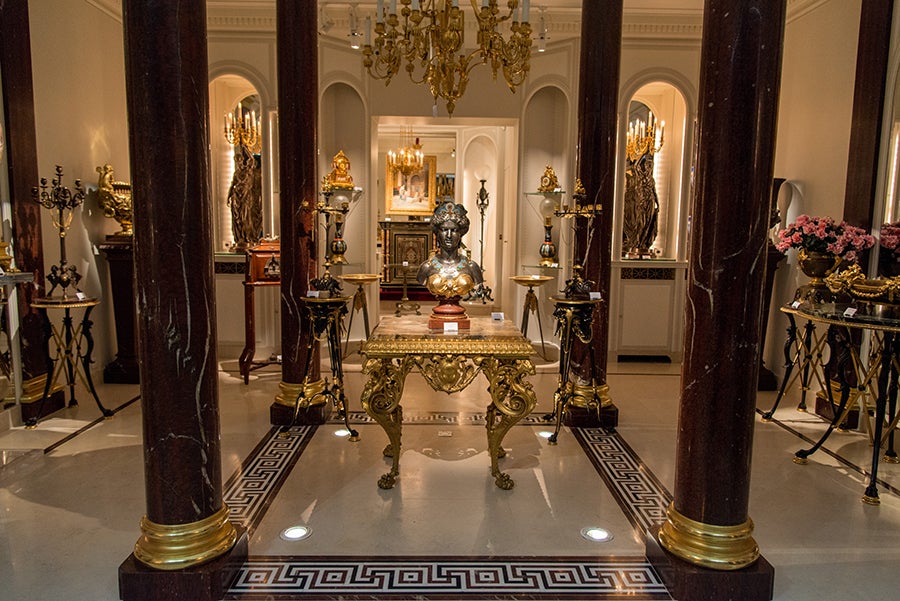
About the Seller
4.9
Vetted Professional Seller
Every seller passes strict standards for authenticity and reliability
Established in 1997
1stDibs seller since 2018
87 sales on 1stDibs
Typical response time: <1 hour
Associations
International Confederation of Art and Antique Dealers' Associations
- ShippingRetrieving quote...Shipping from: PARIS, France
- Return Policy
Authenticity Guarantee
In the unlikely event there’s an issue with an item’s authenticity, contact us within 1 year for a full refund. DetailsMoney-Back Guarantee
If your item is not as described, is damaged in transit, or does not arrive, contact us within 7 days for a full refund. Details24-Hour Cancellation
You have a 24-hour grace period in which to reconsider your purchase, with no questions asked.Vetted Professional Sellers
Our world-class sellers must adhere to strict standards for service and quality, maintaining the integrity of our listings.Price-Match Guarantee
If you find that a seller listed the same item for a lower price elsewhere, we’ll match it.Trusted Global Delivery
Our best-in-class carrier network provides specialized shipping options worldwide, including custom delivery.More From This Seller
View AllNeo-Greek Bronze Bust by E. Cornu and G. Viot & Cie, France, Circa 1867
By Eugène Cornu
Located in PARIS, FR
Signed Machauld et Eug. Cornu – G. Viot et Cie Fondeurs
Bust of a Greek goddess, made entirely of silvered bronze and gilded bronze. The tiara and collar necklace ornating the bust are finely decorated with stylized floral motifs of polychrome champlevé enamel. It rests on a molded base and square plinth made in red griotte marble.
The sculptor Eugène Cornu (1827-1899), installed in Paris at N.29 rue Popincourt, after having worked as a designer and then director for the renowned company Tahan, worked closely with the « Compagnie des Marbres Onyx...
Category
Antique 1860s French Greek Revival Busts
Materials
Griotte Marble, Enamel, Bronze
'African Venus' Bronze Sculpture by C. Marnyhac, France, Circa 1878
By Maison Marnyhac 1
Located in PARIS, FR
An exceptional life-size two patina bronze figure, representing a young African woman taming a snake, dressed with a feathered loincloth and a long drape in her hair, and wearing Afr...
Category
Antique 1870s French Figurative Sculptures
Materials
Bronze
Centerpiece "The Naiad", attributed to G. Denière, France, circa 1870
By Guillaume Denière
Located in PARIS, FR
Exceptional centerpiece in silvered and gilded bronze, composed of a naiad riding a dolphin, supporting a chiseled shell decorated with reeds, adorned with the head of a river god on its bow and on which a winged love blows in a conch. The whole rests on a pedestal decorated with dolphin heads and cut-out leathers, ending with a porphyry base with molded steps.
Historical and artistic context
Centers and naves of tables are attested in France from the Middle Ages in order to present spices and other condiments brought from distant lands around the Mediterranean or from the trade of the Silk Roads. The importance of their presence on prestigious tables will be confirmed throughout the decorative arts, evolving during the 19th century in centerpieces, becoming a central element of decoration.
Here we find a true virtuosity in the composition and representation of the human figure which is reminiscent of the greatest artists of the Italian Renaissance. Indeed, the fluidity of the lines of the naiad can be compared to the nymph of Fontainebleau by Benvenuto Cellini preserved at the Louvre museum and dated 1545, while the naturalist representation of the marine setting refers to the work of Wenzel Jamnitzer...
Category
Antique 1870s French Renaissance Revival Centerpieces
Materials
Marble, Bronze
"The Source" Illuminating Sculpture, Italian School, circa 1900
Located in PARIS, FR
Signed on the base Prof. G. Ca...?
Charming illuminating alabaster sculpture representing a young naked woman leaning on rocks, and seated at the edge of a source concealing a lig...
Category
Antique Early 1900s Italian Art Nouveau Table Lamps
Materials
Alabaster, Marble
Royal Dux Bohemia, Art Nouveau Centerpiece, Bohemia, circa 1900
By Royal Dux Bohemia
Located in PARIS, FR
Bearing the mark Royal Dux and numbered 1252
Large enamelled porcelain centerpiece with golden highlights, representing a nymph sitting on a shell like a ship sailing on the waves, ...
Category
Antique Early 1900s Czech Art Nouveau Decorative Bowls
Materials
Porcelain
"Florentine Singer" Bronze Sculpture by P. Dubois and F. Barbedienne, Circa 1880
By Ferdinand Barbedienne, Paul Dubois
Located in PARIS, FR
Signed P. Dubois 1865 and F. Barbedienne fondeur
Stamped with réduction mécanique Collas
A patinated bronze « Florentine Singer » sculpture, inspir...
Category
Antique 1880s French Figurative Sculptures
Materials
Bronze
You May Also Like
Late 19th Century French Sculpture of Diana di Gabii
Located in 263-0031, JP
A French patinated bronze figure of Diana di Gabii, late 19th century.
Category
Antique Late 19th Century French Neoclassical Figurative Sculptures
Materials
Bronze
$1,984 Sale Price
20% Off
Jugendstil Sculpture 'Judith', Signed E. Tell, Gilt Bronze, Austria circa 1910
Located in Regensburg, DE
Large Jugendstil / Art Nouveau Sculpture entitled 'Judith' by E.Tell from Austria around 1900-1910.
Gilded bronze (bronze dore), heavy execution (circa 29 kg with stone)
Standing o...
Category
Vintage 1910s Austrian Jugendstil Figurative Sculptures
Materials
Stone, Gold, Bronze
Sculpture of Flora, Italy, circa 1880
Located in Greding, DE
Plaster sculpture of flora after a classical original with windswept skirt and pinned up curly hair.
Category
Antique 1880s Italian Neoclassical Statues
Materials
Plaster
Diane of Vesailles, Bronze
Located in Altrincham, GB
Cast Bronze of Diane do Gabries the Hunter, also known as Diane of Vesailles, Goddess/Wife of Artemis, after the Roman Marble Statue in the Louvre, Paris.
Category
Antique Early 1900s European Neoclassical Revival Figurative Sculptures
Materials
Bronze
Muse Calliope Statue by François Moreau Statue, 19th Century
By Hippolyte François Moreau
Located in Lisbon, PT
A statue of thr Muse Calliope, the first of the nine muses of Greek mythology, daughters of Zeus and Mnemosyne, in metal letterhead.
Signed.
Category
Antique 19th Century French Belle Époque Figurative Sculptures
Materials
Metal, Zinc
$2,200 Sale Price
29% Off
Late 19th Century Bronze Statue, Suzanne by Eugene-Antoine Aizelin
By Eugene-Antoine Aizelin
Located in Paris, FR
Bronze statue in brown patina representing Susanna, sculpted by Eugene-Antoine Aizelin (1821-1902). Susanna at the bath is a story from the apocryphal ...
Category
Antique Late 19th Century French Neoclassical Figurative Sculptures
Materials
Carrara Marble, Bronze
More Ways To Browse
Italian Medal
Medal Italy
Italian Female Bust
Egyptian Scarab
Used Furniture Columbus
Greek Red Figure
Bronze Head Sculpture On Marble Base
Ancient Scarab
Woman Statue Italian
Antique Italian Ottoman
Antique Italian Swords
King Of Egypt
Marble Woman Head
Christopher Medals
French Female Statues
Gold Link Belt
Marble Statue Woman
Weapons Swords
